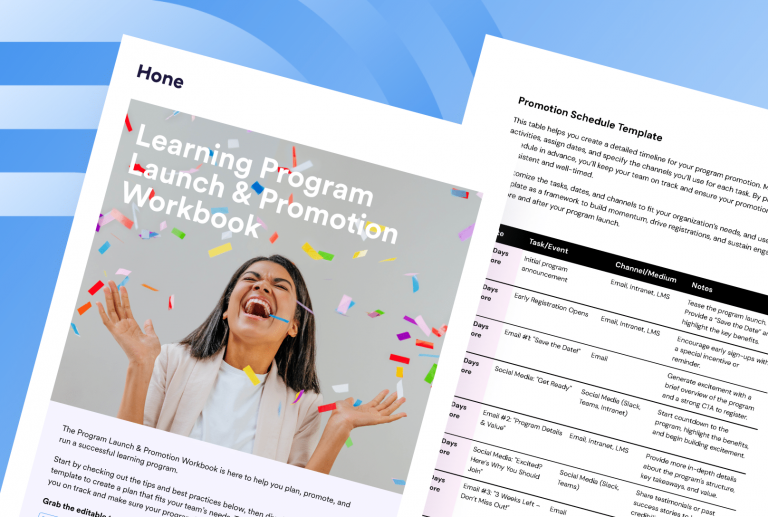What is Workplace Coaching?
Workplace coaching is a process where a more experienced or skilled individual (the coach) helps another individual (the coachee) to develop their skills, knowledge, and abilities to improve their performance and achieve their professional goals. It is a structured and collaborative approach that enables individuals to learn and grow in their roles.
Workplace coaching includes training and equipping them with knowledge and tools. Workplace coaching trains employees to be highly productive. A coach improves learners’ performance or helps them achieve their goals. A coach differs from a mentor. Mentors know more than mentees and answer their questions. But coaching doesn’t require knowing all the solutions, unlike providing advice or mentorship. Instead, a coach has the skills to guide and empower learners to achieve goals.
Why is Workplace Coaching Important?
One of the best ways for managers to support their direct reports is through coaching. The purpose of workplace coaching is it keeps employees’ growth and development while helping them learn and navigate challenges.
The primary goal of workplace coaching is to enable the coachee to achieve their full potential by identifying their strengths and weaknesses and helping them to develop skills and behaviors that enhance their performance. In addition, coaching can address a wide range of professional development needs, including improving communication skills, enhancing leadership capabilities, and developing technical skills.
Coaching is more effective at developing skills than attending seminars. Employees learn quickly because they are actively thinking about problem-solving.
The GROW model is a coaching framework with the following benefits:
- It helps guide others to solutions instead of giving them the answer
- It gets people to be specific in what they want to accomplish
- It requires learners to take precise next steps
- It gets others to think creatively, examine the situation, and assess the options and obstacles
Workplace coaching leverages individuals’ abilities and strengths. It encourages communication, reflection, and self-correction. Because the GROW framework involves introspection and analysis, learners have more self-confidence.
4 Workplace Coaching Challenges
Organizations may experience workplace coaching problems. The following are the four most common.
1. Time & Distance
Coaching requires a time commitment. And a manager has other responsibilities besides coaching their team.
Additionally, teams can be in different departments and parts of the world. But a single coach can only be in one place at a time. Thus, coaching multiple employees can be a challenge.
Video conferencing provides flexibility for coaching remotely. Coaches can influence learners without physically being in the office. Likewise, learners can be in different places to learn together.
Additionally, it can be a time and money saver. Recorded video sessions allow employees to review coaching at their leisure. And future employees can watch recorded sessions.
2. Lack of Objectivity & Interpersonal Skills
Inexperienced coaches – or managers coaching for the first time – may not have the skills to do so effectively. As a result, individuals are prone to forgetfulness, miscommunication, impatience, and other issues. For instance, learners may not enjoy the coaching process if the coach lacks objectivity or bias.
Coaches can avoid emotional fallouts by:
- Encouraging self-reflection.
- Using evidence to support feedback.
- Providing a vision of outcomes.
- Respecting the employee.
Managers can learn how to be a good workplace coaches. Then, just as their direct reports, managers can participate in training programs to be influential leaders.
3. Lack of Long-Term Planning
As mentioned, workplace coaching is a time commitment. Therefore, employees need more than a one-time session to understand subject matters fully. Furthermore, repetition is an essential learning aid.
Organizations can do more harm than good if they do not develop a continuous learning strategy. To create a long-term coaching strategy, they need to have a plan and track progress.
Employees also need to know why the coaching program is essential. Repetition can be tedious for the coach and learner, but valued significance and targets are motivators.
4. Company Culture
Organizations that value learning has employees better receptive to coaching. But an unsupportive culture can have detrimental effects. For instance, one-time coaching sessions may pressure learners to understand topics quickly but not thoroughly.
A positive learning culture has structure and organization-wide collaboration. Individuals can be apprehensive about a sudden initiative. Staff members can be more cooperative if there is a ramp-up process. Additionally, employees should know its benefits and make learning part of their goals.
The 7 Steps of Workplace Coaching
The coach must earn respect and the right to instruct. So often, leaders jump into workplace coaching without taking the time to understand what their people need.
1. Active Listening
Employees trust managers who listen well. Research shows that managers who excel as listeners:
- Resolve team conflicts more quickly.
- Are more likely to retain employees.
- Enhance the creativity of their teams.
The three levels of active listening are internal, focused, and 360-degree. The goal of the combination is for listeners to hear what the speaker is saying and notice the more profound meaning. Similarly, the speaker should feel like the listener is paying attention to what they are saying.
2. Acknowledge & Validate
Everyone wants to be understood and appreciated. Acknowledging” is all about naming the other person’s experience. “Validation” is all about normalizing the other person’s experience. Without it, they can feel isolated, disconnected, or alone.
People rarely move towards collaboration when they don’t feel heard or respected. Learners may be defensive if the coach moves onto powerful questions and problem-solving before making them feel seen or heard. Simply acknowledging and validating the perspective of others halves the time to resolve conflict.
3. Ask Empowering & Probing Questions
Coaches focus on utilizing open-ended, expansive questions by using:
- What.
- Where.
- When.
- Who.
- How.
Sometimes it can be helpful to ask questions that start with, “Why.” However, these can come off as judgmental. And people can shut down if they feel forced to justify their actions. Therefore, coaches need to watch their tone with “Why” questions.
4. Build High-Trust Relationships
The most significant factor impacting job satisfaction is an employee’s relationship with their manager. Leaders focus on their words and actions to develop trust and make others feel safe. Trustworthiness is a combination of credibility, reliability, and professional intimacy.
Managers can cultivate more trust in relationships by telling others:
- Who they are.
- What are their strengths and weaknesses are.
- How they deal with conflict most effectively.
Coaches need to be honest about how they work best. They must communicate these foundational principles. However, others do not feel seen, heard, or respected if people focus on themselves.
5. Give Feedback That Lands
Telling employees what they are doing wrong doesn’t lead to lasting improvements. Instead, they need to understand and address their mistakes from the inside out. Further, managers want to know how their direct reports process feedback.
Feedback often triggers fear in people, no matter how delicately delivered. That fear can manifest as anxiety, anger, or sadness. But leaders can transform this perspective by saying the right things after and changing the conversation’s tone.
For example, asking questions invites the employee into the conversation and makes it feel like a two-way dialogue rather than a threat. Additionally, their answer may make leaders rethink their expectations.
The coach and employee should agree on an action plan. Talking about the next steps shows that feedback is an opportunity to improve. Likewise, managers would benefit from documenting the feedback.
6. Lead Highly Effective 1-on-1
Here is an effective formula based on best practices for great 1-on-1:
- 10% relationship-building – 1-on-1 should start with quick kickoff questions to strengthen the relationship.
- 25% wins – Wins puts the direct report in a positive mindset and get them talking, reflecting, and participating in the conversation.
- 25% frustrations – Ask about employees’ frustrations directly. Often people bottle up their frustrations, and it can be challenging to recognize emotional cues.
- 25% of projects – Talk about project updates and review blockers, if any.
- 15% feedback & recap – Report some positive and some constructive feedback. This shows the employee that the manager cares about their growth.
7. Be Directive
Coaches should determine being directive or supportive on a spectrum. Generally, when someone is less experienced, coaches can be more direct. When someone is more experienced, coaches can be more supportive.
However, even top performers are not uniformly experienced in all areas, so they may sometimes need some direction. Certain times to use directive coaching include:
- When an employee is doing something for the very first time.
- When explicitly asking for advice.
- When in crisis or emotions are high.
- When working on a task that is unusually important and urgent.
Directive coaching is an ineffective way to control an outcome. Likewise, managers should be directive based on how employees look, speak, or think. They must be aware of their biases and address common microaggressions in the workplace.
What are Some Workplace Coaching Scenarios?
Workplace coaching can benefit all stages of the employee life cycle. For example, coaching helps new hires understand their roles and responsibilities during onboarding. It can also help turn former employees into advocates during offboarding. Workplace coaching typically involves a series of one-on-one conversations between the coach and the coachee. The coach provides feedback, guidance, and support to help the coachee set goals, identify obstacles, and create action plans. The coach may use various techniques, such as asking open-ended questions, providing constructive feedback, and setting challenging tasks to help the coachee develop and grow.
But arguably, the more critical stage is during development. Training can help workers better:
- Delegate work.
- Deliver powerful presentations.
- Embrace diversity.
- Have an efficient remote work setup.
- Manage time.
- Overcome resistance to change.
- Run effective meetings and interviews.
- Set powerful goals.
- Utilize their strengths.
Overall, workplace coaching is a valuable tool for organizations to invest in their employees and help them to achieve their full potential. It can improve employee engagement, job satisfaction, and overall performance, leading to greater organizational productivity and success.
3 Workplace Coaching Examples
1. Acknowledge & Validate Vs. Ignore & Invalidate
Four senior-level managers are involved in a cross-functional project. Each is equally responsible for completing the project.
An important deadline is coming, and one manager, Quinn, explains that their team is burnt out. They are worried about their bandwidth. Quinn asks to push the deadline back by another week.
Two managers acknowledge and validate Quinn’s concerns by saying:
- “I know we’re all under a lot of stress here.”
- “It makes sense that we’re all tense about this deadline.”
But one manager, Kennedy, scoffs and says, “No, it’s not possible. We wouldn’t have this issue if your team was properly staffed.”
Kennedy’s reaction to Quinn makes them defensive and feel isolated. Without the acknowledgment and validation of the other two managers, this conversation could go in circles, with neither Kennedy nor Quinn reaching a solution.
2. Building High-Trust Relationships to Give Feedback That Lands
Hollis was recently promoted to a senior position. Hollis’s manager initially recruited them to the company. And they bonded over living in the same neighborhood during the interview. Hollis constantly asks for feedback, and their manager has been impressed with their growth over the past year.
Honor is a hard worker, although it’s hard for their manager to say if Honor has grown much this year. Unfortunately, the honor’s manager rarely provides feedback after they rebuffed the manager’s comments three months ago. As a result, the manager feels uncomfortable in these conversations.
The manager’s relationships with their team members influence their willingness to accept and seek feedback. Additionally, individuals innately receive comments and criticism differently.
Hollis’s and Honor’s manager could try the following steps to give constructive feedback:
- First, focus on what they observed. What happened? Where did it happen?
- Describe the actual, observable behavior, and keep to the facts.
- Avoid generalizations like “often,” “never,” or “always.”
- Next, describe the results of the behavior.
- Help them understand why the feedback is essential to discuss.
- Check to see how the input landed.
- Then, move the conversation to the next steps.
It is the manager’s responsibility to show fairness and foster a trusting relationship. Likewise, they must provide feedback for the organization’s objectives and the employee’s development and growth.
3. Supportive Vs. Directive
Sage’s background is in engineering, and their manager appreciates Sage’s focus on data and logic. Sage’s manager almost always approves of their product decisions. The manager’s coaching focuses on showing up in a supportive role.
Parker’s background is in design, and they are a newer product manager. The manager thinks Parker focuses too much time on the user experience and not enough on the complex data. Recently the manager moved to a more directive coaching style, overriding two of Parker’s product decisions with explicit instructions on the next steps.
Sage’s and Parker’s manager has a specific belief system around how to make decisions. As a result, they take a “supportive” approach with Sage – who shares this belief system – and a “directive” approach with Parker because they value different approaches.
The manager’s directive approach will impact Parker’s level of confidence. It may dissuade them from focusing on a unique strength area moving forward.
Additionally, this may create a more homogenous team culture rather than a culture built on diversity of opinion and approach. While this may save time in the short term, it also may have a longer-term impact on team culture, the psychological safety of the team, and the level of creativity and innovation.
Workplace Coaching in a Nutshell
In conclusion, workplace coaching can be a powerful tool for helping individuals to develop their skills, achieve their goals, and reach their full potential. However, to make the most of workplace coaching, it’s essential to follow some essential steps:
- Establish clear goals: It’s essential to have clear goals and objectives for the coaching relationship so that the coach and the coachee understand what they are working towards.
- Build a trusting relationship: The coach and the coachee need to establish a rapport and trust so that the coachee feels comfortable sharing their thoughts, feelings, and concerns with the coach.
- Provide constructive feedback: The coach should provide feedback that is specific, actionable, and focused on the coachee’s development needs. In addition, feedback should be delivered in a supportive and encouraging way rather than critical or judgmental.
- Set challenging tasks: The coach should set demanding but achievable tasks so the coachee can stretch their abilities and develop new skills.
- Evaluate progress: Regular progress reviews are essential to ensure that the coaching relationship is on track and that the coachee is progressing towards their goals.
By following these steps, workplace coaching can be a highly effective tool for supporting employee development, enhancing job satisfaction, and improving overall organizational performance.














